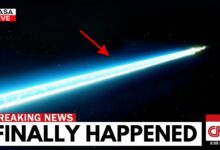Scientists Think There Could Be LIFE on Europa and It’s Even Weirder Than We Thought!

Europa, one of Jupiter’s moons, appears as a frozen, icy world with extreme conditions, including surface temperatures as low as -60°C and constant bombardment from radiation. Despite these harsh conditions, scientists believe Europa could be one of the most promising places in our solar system to search for extraterrestrial life. Beneath its icy shell, an enormous ocean of liquid water may exist, possibly containing more water than all of Earth’s oceans combined. This has led to a growing interest in understanding if life could survive, and what it might look like, on such an extreme moon.

### Key Discoveries About Europa
1. **Surface and Geology**:
NASA’s Galileo spacecraft, which arrived in the Jupiter system in 1995, made the first significant discoveries about Europa. It revealed close-up images of the moon’s surface, showing cracks, ridges, and jumbled landscapes—evidence of a geologically active moon. Galileo also found that Europa’s surface was relatively smooth, with fewer impact craters than expected, suggesting the surface is young and possibly reshaped by icy volcanic flows or other geological processes. These cracks in the ice might allow material from the ocean below to seep onto the surface.
2. **The Hidden Ocean**:
One of Galileo’s most important discoveries was the disruption of Jupiter’s magnetic field around Europa, strongly implying the presence of an electrically conductive layer—most likely a global ocean of salty water beneath the ice. This ocean may be up to 100 kilometers deep, far deeper than any ocean on Earth. Images from the Hubble Space Telescope also hinted at water vapor plumes erupting from Europa’s south pole, which could be similar to geysers, further supporting the idea of a dynamic subsurface ocean.
### How Could Life Survive on Europa?
For life to exist, it typically needs four main ingredients: liquid water, chemical elements, an energy source, and time. Let’s explore how Europa might have all these:
1. **Liquid Water**:
While Europa’s surface is frozen, its interior is kept warm by tidal flexing—a process where Jupiter’s gravitational pull stretches and squeezes the moon, creating frictional heat. This constant flexing likely melts the ice beneath the surface, forming the vast subsurface ocean. Tidal flexing is similar to bending a paper clip repeatedly, generating enough heat to maintain liquid water beneath Europa’s icy crust.
2. **Chemical Elements**:
The chemical building blocks of life—carbon, hydrogen, nitrogen, oxygen, phosphorus, and sulfur—are abundant in the universe and were likely present when Europa formed. Asteroids and comets, which have collided with Europa over time, may have delivered additional organic molecules. For example, the James Webb Space Telescope recently detected significant amounts of carbon dioxide on Europa’s surface, believed to have originated from the ocean below.
3. **Energy Sources**:
Life on Earth relies on sunlight for energy, but beneath Europa’s thick ice, sunlight cannot penetrate. However, organisms could use chemical reactions instead of photosynthesis, similar to how life thrives around hydrothermal vents on Earth’s ocean floor. These vents release heat and chemicals from beneath the Earth’s surface, creating ecosystems in total darkness. A similar process, called chemosynthesis, could occur on Europa if its ocean floor has hydrothermal vents, providing a source of energy for any potential life.
4. **Time**:
Europa is about 4.5 billion years old, meaning its ocean could have existed for billions of years—plenty of time for life to evolve. If life began in Europa’s ocean, it would have had the time necessary to adapt and evolve into complex organisms.
### Life in the Deep Ocean of Europa
To understand what life on Europa might look like, scientists often look at extreme environments on Earth, particularly the deep oceans. In the Mariana Trench, the deepest part of Earth’s oceans, life thrives despite the crushing pressure, cold temperatures, and total darkness. Some species living in these extreme environments include:
– **Snailfish**: The deepest-living fish ever discovered, found at over 8,000 meters below sea level. These fish have special chemicals in their cells that allow them to survive under immense pressure.
– **Xenophyophores**: The largest single-celled organisms on Earth, resembling sponges. They absorb nutrients from their surroundings and could resemble life forms that might survive in Europa’s deep oceans.
– **Shrimp-like Arthropods**: Found in deep-sea environments, these creatures use specialized chemicals to extract nutrients from the seafloor.
Life on Europa, if it exists, might be similar to these extremophiles. Organisms could thrive around hydrothermal vents on Europa’s ocean floor, converting chemicals released from the moon’s interior into energy, much like deep-sea creatures on Earth. Life forms could be microscopic, or there could be larger organisms, perhaps analogous to Earth’s deep-sea fish or strange shrimp.
### Future Missions to Europa
In the coming years, two major missions will study Europa in more detail:
1. **ESA’s JUICE Mission**: The European Space Agency’s Jupiter Icy Moons Explorer (JUICE) launched in April 2023 and will arrive in the Jupiter system by 2031. It will make detailed flybys of Europa to gather more information about its surface and chemical composition.
2. **NASA’s Europa Clipper Mission**: Scheduled to launch in October 2024 and arrive at Europa in 2030, the Europa Clipper mission will be dedicated to studying whether Europa’s ocean has the right conditions to support life. The mission will analyze the moon’s ice shell, ocean, and surface chemistry.
These missions won’t be able to directly confirm if life exists on Europa, but they will provide crucial data about the moon’s habitability. If conditions on Europa are shown to be favorable for life, it would suggest that life could arise in multiple places within the same solar system, making it more likely that life exists elsewhere in the universe.
### Conclusion
Europa’s icy surface hides one of the most intriguing environments in our solar system—a massive, potentially life-sustaining ocean. Although we have yet to discover alien life there, the possibility remains that life, similar to deep-sea organisms on Earth, could exist in Europa’s deep ocean. With future missions on the horizon, we may soon know if this distant moon harbors the conditions necessary to support life, offering profound implications for our understanding of the universe and our place in it.








